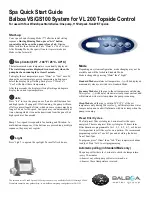
33
Analog Inputs 3 - 4
These inputs have a 100kOhm 5V pull-up resistor and are suitable to measure voltage signals from 0-5V sensors or
devices; either sensors that are being added to a vehicle or pre-existing (or OEM) sensors. Pre-existing/OEM
sensors are presumed to be already connected to a factory ECU or logging device which will require different wiring
considerations. Please refer to the table below for connection examples.
New / Added Sensors
5V Sensor
Power
Sensor Signal
Sensor
Ground
Examples
Three wire pressure
ü
ü
ü
Manifold pressure, oil/water pressure, etc
Three wire position
ü
ü
ü
Throttle/pedal position, linear potentiometer, etc
Three wire flow
!
ü
ü
Check with manufacturer, some MAFs require 12V power
yet output a 0-5V signal
Device
û
ü
ü
AEM 30-4110 UEGO Gauge with 0-5V Output
Existing / OEM
Sensors
Three wire pressure
û
ü
ü
Manifold pressure, oil/water pressure, etc
Three wire position
û
ü
ü
Throttle/pedal position, linear potentiometer, etc
Two wire temperature
û
ü
ü
Intake, coolant/oil temperature, etc
Three wire flow
û
ü
ü
0-5V voltage-style MAF sensor
Device
û
ü
ü
AEM 30-4110 UEGO Gauge with 0-5V Output
ü
=Connect
û
=Don't connect
CAN Output
The measured voltage will be output via CAN and will have to be scaled to the desired units (e.g. temperature,
pressure, percentage, etc) in the receiving device. A thermistor's voltage/resistance varies non-linearly with
temperature and thus the receiving device will likely require a look-up table to properly log or display temperature.
Most non-temperature sensors require a simpler linear scaling. The AEM CD series of dashes have both of these
capabilities; please refer to the appropriate documentation.
Tachometer Input
This input is suitable for measuring engine speed from a variety of sources such as an ignition coil's negative (-)
terminal or an ignition box/driver's 'tachometer' output. If your vehicle is equipped with an aftermarket high-output or
multi-strike ignition system, do
*not*
connect this input to the ignition coil. Instead, use the dedicated tachometer
output wire from your ignition system. "Flying Magnet" or VR style sensors should *not* be connected to the
tachometer input.
CAN Output
The measured frequency will be output in Hertz via CAN and will have to be scaled to engine speed (RPM) in the
receiving device. The AEM CD series of dashes have this capability; please refer to the appropriate documentation.
Fuel Level Sensor Input
This input is suitable for connection to a resistive fuel level sensor. The output of these sensors typically varies from
slightly above 0 Ohms to a maximum of 250 Ohms. It is important that the AEM CAN Sensor Module is the only
device connected to the fuel level sensor. Tapping on to a sensor that is already connected to an OEM ECU (or
similar) will result in inaccurate readings.
CAN Output
Содержание CD-5 Carbon
Страница 12: ...12 Dash Mechanical and Mounting CD 7 Mechanical ...
Страница 13: ...13 CD 5 Mechanical ...
Страница 14: ...14 CD 7F Mechanical ...
Страница 15: ...15 CD 5F Mechanical ...
Страница 16: ...16 Drill Template Drill template prints to scale ...
Страница 17: ...17 Dash Harness and Basic Wiring ...
Страница 18: ...18 Optional OBDII and Power Cable Kits ...
Страница 30: ...30 Create a new output channel using the new function Assign the new output to an item on the display ...
Страница 31: ...31 System Schematic ...
Страница 39: ...39 IMAGE NOT TO SCALE ...
Страница 41: ...41 System Schematic ...
Страница 51: ...51 CAN Transmit Rate Unit 1 50 Hz CAN Transmit Rate Unit 2 25 Hz ...
Страница 58: ...58 ID Type User Configurable 11 29 bits Termination None Ohm DLC 8 Bytes ...
Страница 64: ...64 ...
Страница 65: ...65 ...
Страница 66: ...66 ...
Страница 67: ...67 ...
















































